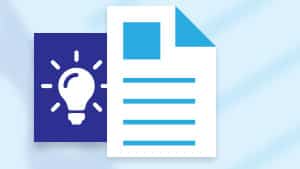The FAQ Module
The solution for upfront requirements gathering

In this article we cover the features and benefits of the FAQ module.
This module was designed to help teams who gather requirements at the start of their requirements management process. By creating question lists teams can easily capture and reuse their knowledge of the elicitation process to ask the right questions that yield the best requirements.
What is the FAQ module?
The FAQ module is a repository of question lists that your team can construct, edit, change, template, and use to elicit requirements. By using the FAQ module to build up a knowledge base for your team, you can be confident that any team member can engage with stakeholders in an effective manner.
By building the best set of questions on that domain, your team can ensure that they are always eliciting the best possible set of requirements.
The main benefit of this module is that it allows your team the opportunity to build up a knowledge base that can be used by both experienced BA’s, as well as by those who might need to elicit requirements in an unfamiliar domain. The FAQ module comes already stocked with over 3000 questions that cover many different topics.
These topics include multiple ISO Compliance templates, as well as templates on Non-Functional Requirement topics such Scalability, Reusability, or Operability that can be used for elicitation.
For many teams this module will replace their Excel-based question lists they may have used in the past.
To stay in line with the other modules in the Modern Requirements toolset, the FAQ module takes what used to be a disconnected process and connects it directly with your project. This means your teams can easily add requirements into your project simply by supplying answers to the questions in your FAQ question list.
What Value does the FAQ module offer?
The value of our FAQ module can be described in two simple points.
- The FAQ module helps create better requirements by guiding the elicitation process, leading to a greater likelihood of project success.
- The FAQ module reduces the time spent on elicitation throughout your project, allowing your team to get started building sooner.
By using the valuable knowledge of experienced BA’s, you can create domain-specific question templates that help structure the elicitation process. This means you can send any BA of any experience level into a room with a stakeholder and feel confident they will create complete and actionable requirements.
By no longer needing to construct question templates and then copy elicited requirements to your RM tool, your team can move through the elicitation process faster. This means more time spent iterating on more accurate requirements and less time spent copy and pasting user stories that are likely to need more work.
What are the Use Cases for the FAQ module?
When we talk to our community about their use of the FAQ module, they often describe the ways in which this module has streamlined their process and made the elicitation phase of projects easier to navigate.
Even with teams who traditionally don’t use question lists, after joining our community they will tell us how much added value they see from being able to consolidate the knowledge of everyone on their team into one cohesive list.
Here are the Use Cases we have seen for the FAQ module.
USE CASE 1
My team currently gathers requirements up front and moves iteratively through our project thereafter. We currently use Excel during the requirements gathering phase, but it means that we are copying requirements to our tool of choice afterwards.
By being a team who gathers requirements up front, this provides a perfect opportunity to use a question list designed for that domain. But using Excel as a means of facilitating this question list is a recipe for a long copy-paste process later down the road.
Copy/paste processes are generally error-prone and lengthy. It is often during these already long copy/paste processes that a team member will recognize they have missed a property of a work item that they need stakeholder input on.
In this case, using the FAQ module means you will have the question list in your Azure DevOps project already. When you ask your Stakeholder your question you will be able to answer that question in your FAQ question list and it will automatically create a requirement for you.
You can then open that requirement directly and pursue any follow up questions that you might have while you are still with your Stakeholder. This saves time and makes the elicitation process more thorough, while preventing your team from missing opportunities to get the right information at the right moment.
USE CASE 2
My team works in a compliant/regulated space and we need to ensure we are building the full set of requirements to remain compliant and auditable.
One of the best features of the FAQ module is that you can use many of our pre-built compliance-related templates to elicit requirements. Our pre-built templates have been created in partnership with many of our existing customers, as well as through partnerships with thought-leaders in these spaces.
In this case, teams with access to the FAQ module can speak to domain experts and consultants and build the question list that will help them create all the requirements necessary for compliance and regulation. Once created, these question lists can be reused in several projects and can be deployed again and again.
How do I use the FAQ module effectively?
The FAQ module provides incredible benefits for teams inside the elicitation phase of their project. Here are some of the ways you can use the module to facilitate project success.
Use the Pre-built Question List Templates
When users need a template on either Non-Functional Requirements, or on ISO topics, they can get started quickly by using one of our built-in templates. These templates already contain many of the most important questions about these topics. Users can start with a pre-built template and remove questions that are not relevant and/or add in new questions that necessary.
Build your own Question List Templates
If one of our pre-built templates does not satisfy your need, teams can easily build question lists from scratch. By starting with a blank template, your team can easily build up a comprehensive set of questions that make eliciting requirements a simple and more efficient process.
Once a question list is built it can be reused across projects to help with your elicitation phase down the road.
Build Question Lists that less experienced members of your team
By building question lists you are effectively providing guidance for any member who might be less familiar with a domain, solution, or system. These lists are then a great tool for guiding newer BA’s, or experienced BA’s from a different domain, during the elicitation phase. Teams understand that the quality of the questions we ask at the start of a project directly reflect in the quality of the requirements we elicit.
By building question lists with our FAQ module, you can ensure that you are getting the best possible requirements the first time.





